Royal Roads Military College
Royal Roads Military College (RRMC) was a Canadian military college from 1940 to 1995, located in Hatley Park, Colwood, British Columbia, near Victoria, British Columbia, Canada.
 | |
| Motto | Truth, Duty, Valour |
|---|---|
| Type | Military college |
| Established | 1940 |
| Chancellor | David Collenette (1993-1995, ex-officio as Minister of National Defence) |
| Principal | Dr. John J.S. Mothersill (1984-1995) |
| Commandant | Captain (N) David B Bindernagel (1994-1995) |
| Undergraduates | 200+ |
| Location | , , 48°26′04″N 123°28′22″W |
| Campus | Hatley Park |
| Closed | 1995 |
| Website | rrmc.ca |
The facility now serves as the campus of Royal Roads University, a public university that offers applied and professional academic programs on-campus and via distance education.
The campus' centrepiece is Hatley Castle, which was erected by architect Samuel Maclure in the early 20th century for British Columbia coal magnate James Dunsmuir and his wife, Laura.[1]
History
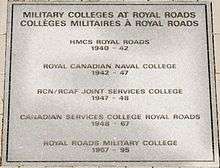
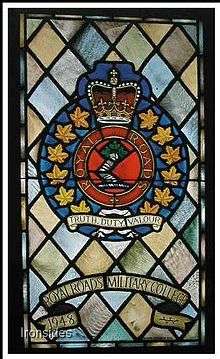

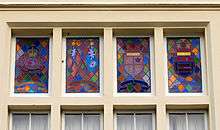
The property owned by industrialist James Dunsmuir, along with his mansion Hatley Castle, was acquired by the Dominion Government in 1940. The initial plan was that the site would be used to house the British royal family during World War II. However, as the Queen Mother put it, "The children will not go without me and I will not go without the King and the King will never go".[2]
Designed to support Canada's naval war effort, the facility began operating in December 1940 as an officer training establishment known as HMCS Royal Roads (named after the Royal Roads naval anchorage). Many of the 600 volunteer reserve officers who underwent training during this time served in the Battle of the Atlantic. HMCS Royal Roads was used to train short-term probationary Royal Canadian Navy Volunteer Reserve (RCNVR) sub-lieutenants to serve in World War II.
In 1942, because of wartime expansion, the Royal Canadian Naval College was established. In 1947, the facility became known as the RCN-RCAF Joint Services College where Royal Canadian Navy and Royal Canadian Air Force personnel were trained. The facility changed its name to Canadian Services College, Royal Roads in 1948 where personnel from all three services - the Navy, Air Force, and Army were trained during a two-year program.
In 1968 the college's name was changed to Royal Roads Military College, and in 1975, the college began granting degrees.
The gentlemen cadets of RRMC were not only required to excel in their respective academic fields, but to achieve the standard in the three other components as well, the Second Language Training component, Physical Fitness component and the Military component. Failure in any of these four components resulted in the officer cadet not being awarded the coveted RRMC degree.
In February 1994, after the end of the Cold War and under the pressure of massive spending cuts from the Government of Canada, the Department of National Defence announced that it would close Royal Roads Military College. The final class graduated in May 1995.
Hatley Park and former Royal Roads Military College was declared a National Historic Site of Canada in 1995 to commemorate the Dunsmuir family (1908–1937) and RRMC (1940–1995). The site was plaqued in 2000 as a Canadian example of an Edwardian park, with gardens, which remains practically intact.
The name Royal Roads was drawn from geography. The name refers to an anchorage located in Juan de Fuca Strait between the city of Victoria, British Columbia and Albert Bay. HMCS Royal Roads was located on a property originally purchased by James Dunsmuir in 1902. Dunsmuir was a former British Columbian premier and lieutenant governor. The Hatley Park Estate originally comprised 650 acres (2.6 km2). The Dunsmuir family added Hatley Castle, which was completed in 1908. The Canadian Department of National Defence purchased Hatley Park, almost in its entirety, in 1940, for $75,000. This sum was roughly the value of the fence surrounding the property.
As Executive Officer, Commander Reginald Amand (Jumbo) Webber D.S.C., C.D. served there till late 1942. On June 21, 1995, after negotiations with the Department of National Defence and the Government of British Columbia, the British Columbia government passed the Royal Roads University Act, creating Royal Roads University. The campus is currently leased from the federal government under a $1, 50-year lease agreement with Royal Roads University which was announced in 2001. The Department of National Defence leases approximately 55 hectares of land for the campus to Royal Roads University, and has entered into a five-year Renewable Management Agreement with the University for the maintenance of the remaining 175 hectares of property owned by the Department of National Defence.
The athletic facilities at Hatley Park included a swimming pool, five tennis courts, two squash courts, three soccer pitches, one rugby field, two ball diamonds, a quarter- mile track, a 6.1 km cross country course, jetty and boat house. Cadets played sports including rugby, soccer, baseball, golf, scuba diving, track and field, wrestling, ball hockey, broomball, and hockey.
Squadrons of the Cadet Wing
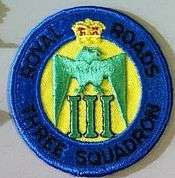
The undergraduate student body, known as the Cadet Wing, was sub-divided into four smaller groupings called squadrons, under the guidance and supervision of senior cadets. Until the late 70's the four squadrons were populated by undergraduate cadets. When the college started training NCMs it was reorganized so that the first three squadrons were for cadets while 4 Squadron was for mature students from the University Training Program Non-Commissioned Members program. Although squadrons were not named, they were represented by embroidered patches bearing mythological figures, which were worn on the sleeves of the cadet workdress. The squadrons were subdivided into flights, which were named after historical figures (explorers). Cadets competed by squadron in drill and intramurals.
| Squadron # | Flight | Flight |
|---|---|---|
| 1 | Cartier | Fraser |
| 2 | Champlain | Mackenzie |
| 3 | Hudson | Lasalle |
| 4 | Vancouver | Thompson |
Band

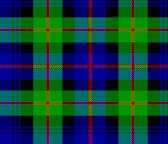
By 1955, Royal Roads had a drum and bugle corps. The Brass and Reed Band had already been formed by 1975. WO George Dunn, the first full-time Bandmaster, served from 1975 to 1979. The Pipes and Drums performed at parades, public relation trips and recruit shows. The Pipe Section and the Drum Section performed at mess dinners; parades; sporting events; ceremonies (official or squadron); weddings; funerals; public relations; wing events; Christmas and Graduation Balls; private events; and holidays.
Notable historical milestones
| Year | Significance |
|---|---|
| 1940 | The Canadian Government purchased the land for Royal Roads. |
| 1941 |
|
| 1942-47 |
|
| 1946 | The Royal Canadian Navy and Royal Canadian Air Force College offered the first two years of university-level programs to Royal Canadian Air Force and Navy officers. |
| 1947 |
|
| 1948 |
|
| 1950 | The Old Brigade, alumni celebrating 50 + years since they entered one of the military colleges, are inducted. |
| 1956 | Scarlet tunics[5] introduced. |
| 1968 | Royal Roads Military College (RRMC) offered the first two years of university-level programs to Royal Canadian Air Force and Navy officers. |
| 1975 | The Royal Roads Military College Degrees Act was passed by the Government of British Columbia, allowing RRMC to grant degrees. |
| 1983/4 |
|
| 1984 | The first female cadet enrolled at RRMC creating a slight shift culturally in the Canadian Military Colleges, as well as in the CF as a whole. |
| May 11, 1986 |
RRMC was granted the Freedom of the City for outstanding military service to the community. |
| 1990 |
Prometheous and the Vulture, an abstract stone sculpture was created by Jay Unwin for the 50th anniversary of Royal Roads Military College. |
| 1995 |
|
Facilities
The Register of the Government of Canada Heritage Buildings lists 9 recognized buildings and 1 classified building on the former grounds of the Royal Roads Military College.
| Name | Address | Coordinates | IDF | IDP | IDM | Image | |
|---|---|---|---|---|---|---|---|
| Belmont Road Main Gatehouse BEL 13 (1908), Royal Roads University formerly Royal Roads Military College | Hatley Park National Historic Site; Recognized Federal Heritage Building 2000, Colwood, BC | 48°26′13″N 123°27′40″W | 2840 | 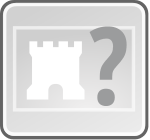 | |||
| Cow Barn and Dairy RR6 (1912–16) | Hatley Park National Historic Site; Recognized Federal Heritage Building 2000; The original Tudor-style dairy and cattle barns were converted into laboratories and classrooms for physics and oceanography. The building was refurbished in 1998 into research and computer laboratories, Colwood, BC | 48°25′49″N 123°28′52″W | 2841 |  | |||
| Grant Block, Building 24 (1942) Royal Roads University formerly Royal Roads Military College | Hatley Park National Historic Site; main academic building, laboratories, cafeteria, and offices named for first Commanding Officer of HMCS Royal Roads, Captain John Moreau Grant. The building, which was designed by architects John Young McCarter with Robert W. Chadney,[9] was recently renovated., Colwood; Recognized Federal Heritage Building 1990, BC | 48°26′07″N 123°28′24″W | 3664 | ||||
| Gymnasium RR22, - sports complex (1942) Royal Roads University formerly Royal Roads Military College | Hatley Park National Historic Site includes gymnasium, weight room, fitness studio, squash courts, outdoor tennis courts. The building was designed by architects John Young McCarter with Robert W. Chadney., Colwood, BC | 48°25′56″N 123°28′42″W | 2844 |  | |||
| Hatley Park National Historic Site (1908)/ Former Royal Roads Military College/Royal Roads University | 2005 Sooke Road; administrative centre of Royal Roads University. From 1941 until 1943 when Grant Block was completed, the Castle served as dormitory and mess hall for cadets and staff officers at RRMC. Classified Federal Heritage Building 1986, Registry of Historic Places of Canada, Colwood, BC | 48°26′04″N 123°28′22″W | 15749 |  | |||
| Nixon Block RR24A (1954 to 1956) Royal Roads University formerly Royal Roads Military College | Hatley Park National Historic Site classrooms, dormitories named after the former LCdr. Edward Atcherley Eckersall Nixon, Royal Navy (RN), Commandant of Royal Naval College of Canada 1911-22, in particular when it was re-established in Esquimalt, British Columbia in 1918, Colwood; Recognized Federal Heritage Building 2000, BC | 48°26′06″N 123°28′28″W | 2843 |  | |||
| Stable / Garage RR4 (1914) Royal Roads University formerly Royal Roads Military College | Hatley Park National Historic Site; Recognized Federal Heritage Building 2000, Colwood, BC | 48°25′52″N 123°28′43″W | 2842 |  | |||
| Swimming Pool RR22A (1959) Royal Roads University formerly Royal Roads Military College | Hatley Park National Historic Site; two-storey, white concrete building composed of horizontal cubic volumes., Colwood; Recognized Federal Heritage Building 2000, BC | 48°25′54″N 123°28′43″W | 2845 |  | |||
| Warrant Officer's Quarters Royal Roads University formerly Royal Roads Military College | Hatley Park National Historic Site, Colwood, BC | 48°25′57″N 123°27′08″W | 4277 |  |
Other buildings
| Building (Year built) | Significance | Photo |
|---|---|---|
| Arbutus Building | academic classrooms, administrative offices, a computer lab, and a canteen | |
| Boat House (1989) | boat house | |
| Coronel Memorial Library | memorial library honours Battle of Coronel |  |
| dock (1990) | dock | |
| Guard House Building 38 | Recognized Federal Heritage Building 2002[11] | |
| Gatehouse Lodge RR8 (1912 to 1916) | Recognized Federal Heritage Building 2000[12] | |
| Hatley Park / Former Royal Roads Military College (1908–13) | designated National Historic Site of Canada 1995[13] | |
| Mews Conference Centre (1912) | James Dunsmuir's stables and garage later converted to classrooms, dormitory, social centre and conference centre. Registered Federal Heritage Building[14] | |
| Millward Wing (of the Nixon Building) (1991) | Offices, dormitories, named for former Commandant Air Vice-Marshal James Bert Millward DFC (Bar), GdG(F), CD, RCAF 1949-52 the 4th Commandant of RRMC. | |
Royal Roads Military College Museum
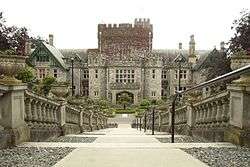 | |

| |
| Location | Hatley Castle, on the campus of the Royal Roads University |
|---|---|
| Website | www.rmc.ca/other/museum/index_e.html (Official) |
Hatley Castle is home to the Royal Roads Military College Museum.
The museum is located in Hatley Castle, on the campus of the Royal Roads University and former campus of the Royal Roads Military College of Canada. The Museum mandate is to collect, conserve, research and display material relating to the history of the Royal Roads Military College, its former cadets and its site.
The Royal Roads Military College Museum is a member of the Canadian Museums Association and the Organization of Military Museums of Canada Inc. The Royal Roads Museum is an accredited museum within the Canadian Forces Museum System.[15]
The museum has formed a cooperating association of friends of the museum to assist with projects.[16]
 Royal Roads Military College mace
Royal Roads Military College mace- Royal Roads Military College chair
 Canadian Military College uniforms
Canadian Military College uniforms Canadian Military College rank and year bars
Canadian Military College rank and year bars.jpg) Canadian Military College badges and buttons (post-1953 crown)
Canadian Military College badges and buttons (post-1953 crown) The Log Royal Roads Military College yearbook
The Log Royal Roads Military College yearbook Royal Military College of Canada alumni button
Royal Military College of Canada alumni button Royal Roads Military College Plaque
Royal Roads Military College Plaque
Traditions
| Tradition | Significance |
|---|---|
| Blanket toss | Blanket toss of senior class members after the last waltz at the Graduation ball |
| Ceremonial mace | Symbolizes the authority of the college, as granted in the name of the Sovereign (currently Her Majesty Queen Elizabeth II). When carried into the ceremony and placed on stage, the mace signals the opening of the convocation. It was last used at the RRMC postgraduate convocation in 1995. The mace's four sides commemorate the sequence of institutions at Royal Roads. It was made prior to the first graduating class from Royal Roads Military College in May 1977. |
| 'Change of command ceremony' | The former commandant offers farewell and best wishes to the college and to the new commandant. The new commandant accepts a first salute as the cadet wing marches past. |
| Christening bell | Following naval tradition, a ship's bell was used as a baptism font in the college chapel for christenings and the names of the children were later inscribed on the bell. The ship's bell from RRMC is currently used in the chapel at Royal Military College of Canada. |
| HMCS Royal Roads' bell | During the life of the college, HMCS Royal Roads' bell was displayed in the porte-cochere of Hatley Castle. After the closing of RRMC, HMCS Royal Roads' bell was kept in the museum at CFB Esquimalt. It was officially repatriated on 10 September 2010 during the Royal Roads University 2010 Homecoming. The bell is prominently displayed in the new entrance to Grant block in the foyer that links Grant block and the new academic building. |
| College toast | RRMC club toast to absent comrades meaning those who have fallen in action or otherwise died |
| Colours | After the last parade of RRMC in spring 1995, the colours were deposited into the care of Christ Church Cathedral in Victoria, British Columbia where they are on display with several other retired colours including "Royal Canadian Navy" and "Royal Canadian Air Force". |
| Feu de Joie | An honour guard perform a rifle salute with field artillery, or more commonly, rifles using blank ammunition. |
| Ghosts and haunting | The B.C. Society of Paranormal Investigation and Research into the Supernatural have investigated stories of paranormal activity in and around Hatley Castle[17] |
| Grace |
|
| Graduation and Commissioning Parade | in honour of graduating cadets:
|
| Jacket exchange | The RRMC Director of Cadets exchanges tunics with a I Year Officer Cadet at RRMC Christmas Dinner. |
| Just Passing By | When a graduate of the RRMC pilots an aircraft in the vicinity of Victoria, British Columbia he or she conducts an impromptu airshow over the college. |
| Lord Horatio Nelson's quote hung over the entrance to the Grant Building | A replica of the quote, "Duty is the great business of a sea officer: All private considerations must give way to it however painful it is." was returned to Royal Roads University campus for Homecoming in 2011. |
| Marches | Quick - Hatley Park; Slow - Royal Roads Slow (Going Home) |
| Naval heraldry |
|
| Obstacle course race | Course for recruits set up by the cadets' immediate predecessors |
| Old Brigade | Alumni who entered military college 50+ years before wear unique berets and ties, have the Right of the Line on reunion weekend memorial parades, and present the College cap badge to the First Year cadets on the First Year Badging Parade. Each class traditionally marks its 50-year anniversary and entry into the Old Brigade with a gift. |
| Skylarks |
|
| Sweetheart brooch | Officer cadets gave their dates an enamel brooch in lieu of a corsage for formal dances at Christmas, and Graduation. |
| White peacock | Blue Indian peafowl have lived free on the college grounds since the 1960s. Albert, a rare white peacock resident since RRMC days, died in 2003.[19] |
Commandants
| # | Name | Year | Significance | Photo |
|---|---|---|---|---|
| Captain John Moreau Grant, CBE, RCN | 1940-42, 1942–46 |
|
||
| Captain W. B. Creery, CBE, CD, RCN | 1946-48 | 2nd Commandant, RRMC | ||
| Captain Herbert Sharples Rayner, DSC (& Bar), CD, RCN | 1948-49 | 3rd Commandant, RRMC; As Vice Admiral, Rayner was 8th & last Chief of the Naval Staff 1960–1964. | ||
| Air Vice Marshal James Bert Millward DFC (Bar), CdeG(F), CD, RCAF | 1949-52 | 4th Commandant, RRMC[20] | ||
| 2253 | Major General Cameron Bethel Ware DSO, CD, PPCLI (RMC 1931) | 1952-54 | 5th Commandant, RRMC | |
| 2444 | Captain John A. Charles, CMM, CD RCN (RMC 1935) | 1954-57 | 6th Commandant, RRMC | |
| Colonel P.S. Cooper OBE, CD, L Edm R | 1957-60 | 7th Commandant, RRMC | ||
| Group Captain Alan Frederick Avant DSO, DFC, CD, RCAF | 1960-63 | 8th Commandant, RRMC[21] | ||
| 2576 | Captain William Prine Hayes CD, RCN | 1963-65 | 9th Commandant, RRMC | |
| Group Captain O.B. Wurtele, CD, RCAF | 1965-68 | 10th Commandant, RRMC | ||
| RRA18 | Colonel Kenneth E. Lewis CMM, CD CF (RRMC ‘47) | 1968-70 | 11th Commandant, RRMC | |
| Capt(N) R.C.K. Peers CD CF | 1970-76 | 12th Commandant, RRMC | ] | |
| Colonel J.H. Roddick CD, CF | 1976-79 | 13th Commandant, RRMC | ||
| 3912 | Colonel George L. Logan CD CF (RHC) (RRMC/RMC ‘57) | 1979-83 | 14th Commandant, RRMC; `Colonel George Logan` (1983) march composed by OCdt David V. Ferguson in his honour | |
| 4271[22] | Capt(N) William J. A. Draper CD CF Adec | 1983-84 | 15th Commandant, RRMC | |
| 6440 | Captain (N) A.J. ('Tony') Goode CD CF (Royal Military College Saint-Jean/RMC 1965) | 1984-87 | 16th Commandant, RRMC | |
| 7264 | Colonel Ross K.R. Betts CD CF (RMC 1967) | 1987-89 | 17th Commandant, RRMC | |
| 8335 | Colonel Claude J.E.C. Naud CD A de C. CF (CMR/RMC 1970) | 1989-91 | 18th Commandant, RRMC | |
| 8241 | Lieutenant-General (ret'd) Vaughan Michael Caines, A de C, CF (CMR/RMC 1970) CMM, CD | 1991-94 | 19th Commandant, RRMC; Chair of the DND/CF Ombudsman Advisory Committee | |
| 9318 | Captain (N) David B. Bindernagel CD (RRMC RMC 1972) | 1994-95 | 20th Commandant, RRMC |
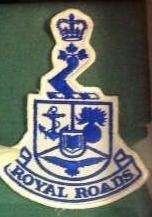
Principals
| Name | Year |
|---|---|
| Commander Ketchum | 1942-45 |
| Captain Ogle | 1945-51 |
| Professor Brown | 1951-55 |
| Professor Cook | 1955-61 |
| Professor Graham | 1961-84 |
| 3237 Doctor John J.S. Mothersill (RMC 1954) | 1984-95 |
Notable professors
| # | Name | taught | Significance |
|---|---|---|---|
| Sir C. S. Wright | RRMC 1967-69 | explorer, Terra Nova Expedition | |
| Frank Davey | RRMC 1963-1966; 1967–1969 | poet, author |
Notable alumni
| # | Name | Grad | Significance | Photo |
|---|---|---|---|---|
| 13705 | Constable José Manuel Agostinho | RRMC 1982 |
Royal Canadian Mounted Police officer, was killed in the performance of his duties near Millet, Alberta, on 7/4/2005. He is remembered on the Canadian Police and Peace Officer's Memorial (panel 14-26).[23] |
|
| 14008 | Alan Cumyn | RRMC 1983 | Canadian novelist | |
| RCNC115 | Honourable Douglas Everett | RCNC 1943-45 | Canadian automobile dealer, lawyer, and retired Senator | |
| 11510 | Barry Kennedy[24] | RRMC ‘77 | fighter pilot, comedian, author, host of Discovery Channel's Out In The Cold | |
| RCNC40 | Bev Koester | RCNC40 1944 | Canadian naval officer, civil servant and Clerk of the Canadian House of Commons | |
| 3528 | General (Ret) Paul David Manson O.C., CMM, CD, B.Sc., D.M.S. | RRMC 1956 | Military leader, business executive and volunteer; former Chief of Defence Staff | 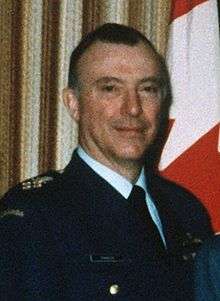 |
| 13738 | Colonel (Ret'd) Chris Hadfield | RRMC/RMC 1982 | Astronaut | 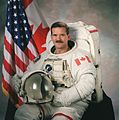 |
| 5576 | Leonard Lee | 1960 (RRMC); 1962 (RMC) | founder of Lee Valley Tools and Canica Design. | |
| 12320 | General Walter Natynczyk CD | RRMC CMR 1979 | Military leader, Chief of Defence Staff | 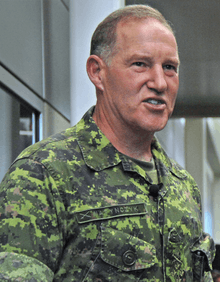 |
| Hubert Seamans | RRMC 1973 | businessperson, banker, politician | ||
| RCNC205 | Jim Thompson (powerboat racing) | RRMC 1944 | businessman, athlete | |
| RCNSE54 | Rear Admiral Robert Timbrell, CMM, DSC, CD | RCNC 1937 | Military leader | |
| General Jonathan Vance CMM MSC CD | Chief of the Defence Staff of the Canadian Armed Forces | 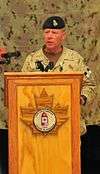 | ||
| 14098 | Chris Wattie | RRMC 1979 | soldier, journalist, author |
Quotes
| # | Name | Quote |
|---|---|---|
| Mr. Kasper, 3rd Session, 35th Parliament, Legislative Assembly of British Columbia |
|

Filming location
The campus of Royal Roads has been used as a film set for:
- Professor Xavier's School for Gifted Youngsters in the "X-Men (film)" movies.[26]
- The Luthor Mansion, the estate belonging to Lex Luthor in TV series Smallville
- The Shady Glen School in the 1997 movie, Masterminds
- The hideout in MacGyver, season 5, "The Legend of the Holy Rose, part 2"
- The home for the Royal Family in the Seven Days TV series, episode 9, season 2, "Love and Other Disasters"
- Little Women, starring Winona Ryder (1994)
- The Changeling, starring George C. Scott (1979)
- The Queen mansion in the CW series "The Arrow" (2012)
Books

- Doug Cope "The Roadants" (Royal Roads Military College, Victoria, BC 2013)
- Peter J.S. Dunnett & W. Kim Rempel Royal Roads Military College 1940-1990, A Pictorial Retrospective (Royal Roads Military College, Victoria, BC 1990)
- Maurice Robinson, Bev Hall, Paul Price Royal Roads : a celebration (Natural Light Productions, Victoria, BC, 1995)
- "Royal Roads - a public university with a difference" : a proposal prepared by Hatley Educational Society for presentation to the Advisory Panel on the Future of Royal Roads (Hatley Educational Society, British Columbia 1995)
See also
- Royal Military College of Canada
- Royal Military College Saint-Jean
- The Canadian Crown and the Canadian Forces
- Monarchy in British Columbia
- Royal Roads University
- Canadian Military Colleges
References
- "Residence of James Dunsmuir, British Columbia, Architect: Samuel MacLure". Construction (Toronto). Victoria. 9 (7): 214. July 1916.
- "Speech by Iona Campolo, Retired Heads of Mission Association's Gala Dinner", Royal Roads University, Hatley Castle, 5 February 2007, Office of the Lieutenant Governor
- "McCarter, John Young". Dictionary of architects in Canada. Retrieved 19 Aug 2014.
- A history of Sport at Hatley Park Archived 2011-06-13 at the Wayback Machine
- Attendance at RR 1954-6. Measured for but not issued. Scarlets were not used at RR previously.
- RRMC band Archived 2012-04-23 at the Wayback Machine
- The Future of the Reserves - Dr. Klepak Archived 2009-05-02 at the Wayback Machine
- Royal Roads Homecoming 2011
- "John Young McCarter". Dictionary of architects in Canada. Retrieved 19 Aug 2014.
- Directory of Federal Real Property Treasury Board of Canada Secretariat
- Register of the Government of Canada Heritage Buildings Archived 2011-08-14 at Archive.today
- Registry of Historic Places of Canada
- Registry of Historic Places of Canada - Hatley Park
- Registry of Historic Places of Canada - Stables
- Royal Roads Museum Archived October 22, 2008, at the Wayback Machine
- Canadian Forces Museums Archived October 18, 2008, at the Wayback Machine
- Royal Roads University - Ghosts in Hatley Castle
- CFB Esquimalt Naval and Military Museum badge project Archived 2011-06-23 at the Wayback Machine
- InRoads - February 2003
- Major J.M.Stephens, CD. "Millward, James B". Kilby.sac.on.ca. Retrieved 2012-04-27.
- Veterans of Valour Colonel Avant
- A classmate. Biographies 1953-1954 to 2003-2004 ed. by Howard Ross Wheatley
- "Canadian Police & Peace Officers Memorial - Profile - José Agostinho". Cacp.ca. Retrieved 2012-04-27.
- Barry Kennedy
- Robinson completes family circle at Royal Roads
- Most Popular Titles With Location Matching "Royal Roads, Colwood, British Columbia, Canada"
- Royal Roads University Archives Digitizes Royal Roads Cadet Yearbooks 1943-95
- Karen Inkster 'The best two years...: Narratives of Royal Roads Military College (RRMC) Ex-cadets (1940–1995)' at the Military and Oral History Conference: Between Memory and History on May 7, 2010, Victoria University, British Columbia.
- Karen Inkster 'Coming Full Circle: Remembrances of Royal Roads Ex-Cadets' DVD documentary Victoria, British Columbia
External links
| Wikimedia Commons has media related to Royal Roads Military College. |
- "Military and Staff Colleges" in The Canadian Encyclopedia
- Cadet Life at Royal Roads Military College: The Log yearbooks from 1943 to 1995
- Hatley Castle
- Stay in School National Film Board of Canada (1964) Documentary about high school students who tour Royal Roads